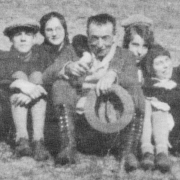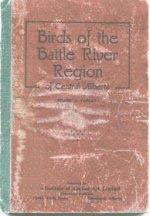Frank Farley
Francis (Frank) LeGrange Farley, son of the late John Farley, K.C., was born in St. Thomas, Ontario on Feb 42, 1870. He was one of six children, two sons and four daughtes. His brother, John Egerton Farley, was killed in action in the Boer War. Mr. Farley was fitted for a career in the public schools of his native city and at the Collegiate Institute, where he graduated in 1889, and then engaged in the banking business for two years. But the developing regions of Western Canada attracted him. He arrived at the fledgling hamlet of Red Deer in 1892 which he determined to identify himself permanently with this country.

Frank Farley with a group of students near Camrose, Alberta in the mid-1920’s Photo: Courtesy of the Red Deer and District Archives
He took up a homestead and engaged in farming near Innisfail for fifteen years. Within weeks of his arrival, Farley started exploring the region. His first trip was to the coalfields near present day Ardley. In three days of travel, he did not meet a single person. Later excursions took him to the Buffalo Lake country and to the foothills near present day Nordegg where he discovered unusual caves.
In 1902 Farley entered the real estate and insurance business in Red Deer. Later he became the local agent for the Bell Telephone Company.
He sold his farm and in 1907 relocated to Camrose, where he conducted a brokerage business. He was also been a member of the City Council since the incorporation of the city in 1907. He was a progressive, public-spirited citizen and one who carried the prestige of leadership through the long experience of a business man.
Despite his extensive business and community involvements, Farley continued his annual expeditions. In 1919, he traveled down the Christina River in Northern Alberta. A few years later, he journeyed to the Hudson Bay. Farley became a prolific writer. His book, Birds of the Battle River (1932), is still an important reference.
He wrote regular reports for the U. S. Bureau of Agriculture and started a conservation program for hawks. But it was in the realms of Natural history and ornithology that Mr. Farley found great interest and satisfaction. He was recognised as an international authority on North American bird life. Mr. Farley started his studies in ornithology before leaving Ontario, and had made a survey for the Ontario Government of bird life in Western Ontario.
 When Mr. Farley married in 1896, he had hunt for three days to find a man to issue the license. The license officials were very scarce at that time. There were but two banks in the territory, one in Edmonton, the other in Calgary. Trade was conducted largely on the primitive basis of barter and exchange. Some of his early experiences furnish some excellent illustrations of this basic principle or political economy. Among the settlers of his neighbourhood the principal commodities of exchange were hay, stock or labour. He had arrived at Red Deer with a working capital of only fifty dollars.
When Mr. Farley married in 1896, he had hunt for three days to find a man to issue the license. The license officials were very scarce at that time. There were but two banks in the territory, one in Edmonton, the other in Calgary. Trade was conducted largely on the primitive basis of barter and exchange. Some of his early experiences furnish some excellent illustrations of this basic principle or political economy. Among the settlers of his neighbourhood the principal commodities of exchange were hay, stock or labour. He had arrived at Red Deer with a working capital of only fifty dollars.
He prized among his acquaintances many authorities on bird life whom he had met on various pilgrimages.
Mr. Farley lived simply, but he had done many of the things he wanted to do. He was widely travelled, all through Canada and the United States, from the Caribbean to the Arctic Circle, and in Europe, all this without losing the touch with his intimate friends.
Farley passed away in October 1949. The Camrose Canadian wrote, “He was a prime example of how to grow old gracefully.” His name continues on, however, with his famous nephew, Farley Mowat.
